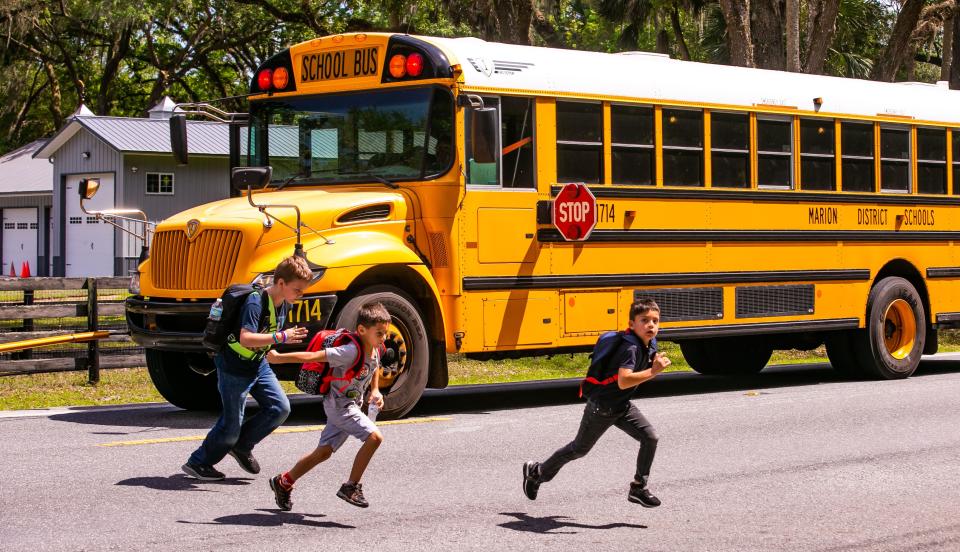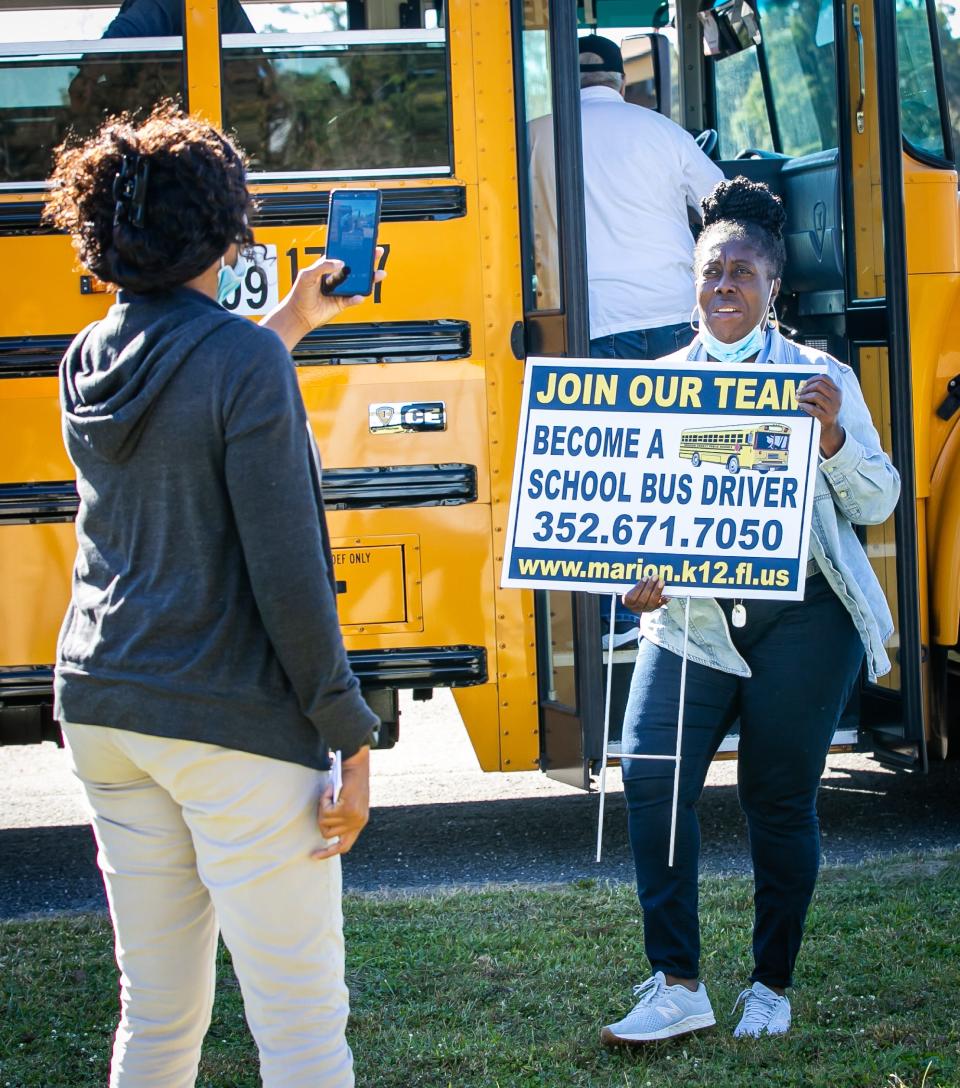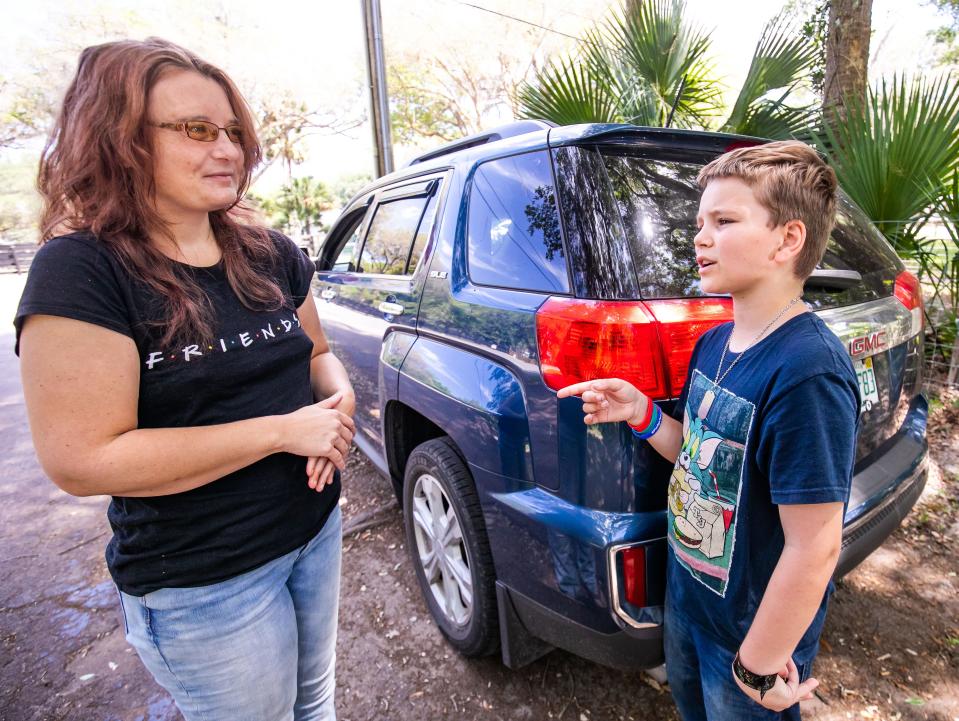'Here Comes the Bus': New app allows Ocala/Marion parents to track child's school bus
During a time when school bus driver shortages have led to delays in routes, parents now have a new tool that will let them know when their child's bus arrives at their child's bus stop in the morning and afternoons.
The "Here Comes the Bus" application, which can be downloaded in the Google Play store for Android devices or the Apple Store for iPhone and iPad devices, allows parents to track their child's school bus.
Kevin Christian, Marion County Public Schools' public relations director, said the Synovia Solutions LLC app was tested before Monday's roll out. He said district staff was asked to use it to see what they thought.
March 2017: School bus drivers wanted
January 2021: 'Crisis mode:' Marion school board wants to double wage of temporary bus drivers
August 2021: Bus driver shortage, worsened by COVID-19, plagues Marion's first week back to school
"Staff, including myself, actually piloted the system for a few weeks before we introduced it publicly to make sure that it was working properly," Christian said. "I would get a notice that the bus was approaching the bus stop in the morning and in the afternoon. It works. It works great."
The app utilizes GPS services to provide parents a visual bus route reference on mobile devices so that families can better plan for the bus arrivals in advance.
"The app serves as an additional outreach to enhance communication between the district and families and can be used every school day," according to a district statement. "The district will continue using Skylert messaging via telephone, email and text to share information with families regarding bus schedules and delays."
After downloading the free app, users must use the Marion County Public Schools access code, which is 670. Then they must provide an email address and their child’s student identification number (lunch number) to create an account.
Users with questions can contact the school district's transportation department at 671-7050 or visit https://www.marionschools.net/Page/93578.
For safety reasons, parents can only track their child's bus. The app does not allow for random tracking of buses. People without a child in the school system, and families where the student does not ride a bus, cannot access the app.

Marion County School Board Chairman Eric Cummings said the district continues to be in need of more bus drivers. He said some drivers are still driving two routes and that some children are still arriving late to school and late getting home.
He noted that the delays have frustrated parents, as well as staff needing every minute to teach the children. He said the district is still trying to add drivers, a shortage that is hitting many districts around the nation.
"I don't expect the app to solve all the issues," Cummings said. "But this will help minimize some of the issues that we've been having with transportation and alleviate some of the stresses the delays have created for some parents."
Christian said the district had to pay for GPS technology upgrades on 325 buses, specifically increasing bandwidths from 3G to 4G. The cost of the upgrades and the mobile app was $429,000, or about $2.45 per bus per day.
GPS used to track buses since 2009
The school district began installing GPS devices on buses in spring 2009. It was initially designed to ensure efficiencies in route times to reduce fuel costs.
The initial cost of the system was estimated at $377,000 for 450 buses. Today, there are 360 buses in the Marion County fleet, thanks in part to more efficient bus routes mapped using the GPS system.
Today, Marion County has 21,263 bus riders. In 2019, Marion had the 84th largest school bus fleet among nearly 14,000 public school districts in the nation. Marion County's land size is larger than Rhode Island.

The initial GPS tracking in 2009 did not involve individual students. Tracking was only accessible to a few district transportation officials. About a decade ago, the district briefly explored a plan to track individual bus riders.
The idea, which was never implemented due to privacy concerns, included equipping students with wristband trackers or a devices clipped to backpacks.
"There was discussion that would help us better track bus riders, specifically when a student gets on and off the bus," Christian said. "But that was nixed pretty quickly because we felt it was it was too personal, mainly because the device went everywhere with that child."
Since the "Here Comes the Bus" app was introduced on Monday, 2,189 accounts, representing parents of 2,620 students, have been created.
"So you know we're at 12% (of all bus riders) in less than three days," Christian said. "I think that's a good good start."
Some parents already track kids with cell phones
The "Here Comes the Bus" app is rated 3 out of 5 stars in the Google Play store. Many local parents say that until issues with bus delays are resolved they will continue to be late to work waiting on buses and an app can't solve that concern.
Ocala parent Jennifer Poole said in a Star-Banner Facebook post seeking comments about the app that the "location app is honestly useless for pickup and drop off."
"I have it," she said. "My son is in middle school and the bus does two runs (routes). It’s nearly impossible to tell which one he is on. It honestly is great when your child is on a bus and it's running late, but it does not solve any issues (if the bus has two routes)."

On Wednesday, Ocala mom Amber Powell waited at a Magnolia Avenue bus stop to pick her child. While standing with her 10-year-old son Samuel, a fifth-grader at Shady Hill Elementary School, Powell said she uses an app called Life360 to track her older son.
Life360 is an app that tracks cell phones, giving precise locations.
"I already have a tracker app on my son's phone," Powell said. "But if his phone dies, I can use the school's app as a back up."
Marion resident Andy Lazar, who doesn't have a child who rides the bus, said he thinks the app is a great idea.
"In addition to the convenience factor, I immediately thought of the safety aspect of it," he noted in a Facebook post seeking comments. "Instead of a child standing on the dark side of the road, they can wait in a much safer location and then time their arrival to the stop as the bus arrives. No way to quantify it, but this will save lives!"
Officials hope the new app will relieve some stress
Cummings said that the app is a work in process and he hopes "it'll help with the communication with parents." Cummings equated the app to tracking flights at the airport.
"It's almost like having a flight board telling you whether the flight is going delayed and parents can have it in their pocket," said Cummings, adding that the app should be able to enhance any other tracking app a parent may have on their child's phone.
Cummings said the bus driver shortage has meant that some students are arriving late to school. He said those issues are frustrating parents and that the district, like many districts around the nation, are trying to recruit more people.
"I'm not sure how we can get bus drivers because there's a lot of issues," said Cummings, adding that potential hires say the pay is too low for the responsibility of trying students safely to school.
Bus drivers make on average about $15.65 per hour, up a few dollars since 2017. The district is short 20 drivers and 53 drivers are currently driving two routes per day, Christian said. To combat the current delays, Cummings said the district is looking to stagger school start times so bus drivers can do two routes.
Joe Callahan can be reached at (352) 817-1750 or at joe.callahan@starbanner.com. Follow him on Twitter @JoeOcalaNews.
This article originally appeared on Ocala Star-Banner: New app allows Ocala/Marion parents to track child's school bus

